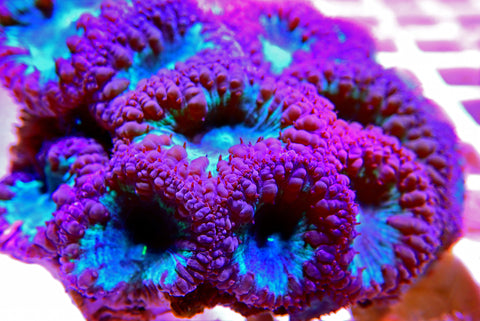BLASTOMUSSA CARE OVERVIEW
LIGHT: Low-Moderate (75-125 par) Lighting is best. It is easy to damage coral with too much lighting so in our opinion when it comes to lighting, less is often more for LPS corals. You can learn more about Lighting and it's overall impact on your reef tank in our article Lighting and your Reef Tank
FOOD: Blastomussa tend to have hungry mouths and nice polyps for feeding. They like to capture nutrients from the water column and will do best when supplied a healthy amount of food. Our method is high import, high export. You can learn more about Feeding and Filtration in our article Feeding, Filtration and your Reef Tank.
FLOW: Because of the large polyp nature of these corals, we need to make sure the flow is strong enough and random enough to continually bring food particles to the coral's mouth while not being so aggressive that the coral has trouble capturing, or worse, has its flesh damaged by the strong current. You can read more about Flow and its overall impact on your reef tank in our article Flow and your Reef Tank
DIFFICULTY: Moderate. As is typical with most LPS these corals are not the most difficult to keep. Still, we would not label them as beginner level. These corals can really thrive when the right combination of Food/Light/Flow and Filtration are achieved, but in our opinion requires a moderately experienced reef keeper that is able to adapt their reef for this corals requirements
PRICE: Moderate to High. Some of the typical varieties can be found on the moderate end of price per polyp. These would include your red/teal and purple/teal varieties which are the most common. On the high end Blastomussa can get quite costly per polyp as rare coral morphs are in high demand
COLLECTION ZONE: Indo-Pacific
NATURAL TEMPERATURE: 82 °F / 28 °C although most corals can adapt and survive in temps as low as 77 degrees and as high as 84 degrees. You can read more about temperature and how it affects your reef tank in our article Temperature and your Reef Tank.
PH: Recommend 8.0-8.4, we tend to run around 8.2-8.3 over 24 hours. You can read more about pH in our article pH and your Reef Tank
NITRATE: 5-10, try to keep stable. You can read more about nitrate and our approach to maintaining it in our article Nutrients and your Reef Tank
PHOSPHATE: 0.05-0.1, try to keep stable. You can read more about Phosphate and our approach to maintaining it in our article Nutrients and your Reef Tank
ALKALINITY: Recommend 8-9 dKh. You can read more about how we maintain our alkalinity in our article Alkalinity, Calcium and your Reef Tank
CALCIUM: Recommend 400-450. You can read more about how we maintain our calcium in our article Alkalinity, Calcium and your Reef Tank
The Blastomussa coral is a large polyp stony (LPS) coral. It is often referred to as a "pineapple coral." A striking coral to behold, Blastomussa corals appear in shades of red and green, but can appear mottled with other colors as well. There are 2 types of Blastomussa corals, the Blastomussa merletti and the Blastomussa wellsi. The main difference between the Blastomussa merletti and the Blastomussa wellsi is the size of the polyps. A Blastomussa merletti has smaller polyps which will usually max out in size at 1 inch in diameter they typically grow stalks and do not encrust. A Blastomussa wellsi has larger polyps that will range in size from 1 to 5 inches in diameter and typically will encrust over rocks. Both species of Blastomussa coral require similar care but it is the Blastomussa wellsi that is the most sought after and desirable.


When deciding on where to place your Blastomussa coral, consider lighting and water movement requirements. Blastomussa corals should be placed in your aquarium where there is low flow and low to moderate light. They are likely to do better in a spot with lower light than one with high light. We recommend 100 PAR. When exposed to too much light, sections of their polyps become irregularly inflated and bubbles may form inside of the flesh. Too much flow may damage their polyps. It is recommended that a Blastomussa coral be placed on a rocky substrate to limit the sand settling on the polyps if your tank's inhabitants are known to kick up sand.
Through their symbiotic relationship with a photosynthetic algae, known as zooxanthellae, they receive many of their nutrients. They also filter-feed on the nutrients, brine shrimp, and krill in the water column. To maintain good health, calcium, strontium, and other trace elements should be monitored and added as needed.


Blastomussa corals are usually peaceful, but can still sting corals that are positioned too close. Anemones, mushroom polyps, and many other corals could potentially damage the polyps of a Blastomussa coral, particularly the large polyps of a Blastomussa wellsi. So, be sure to give them some space to grow and thrive safely.
